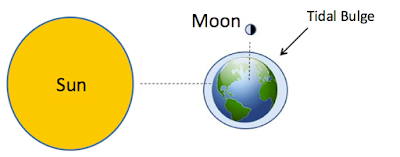Tides are periodic, short-term changes in the height of the ocean surface at a particular place caused by a combination of the gravitation force of the moon & sun & the motion of the Earth.
- Sparing Tides:When the moon, sun & earth are located along the same line, then the attraction power of the moon & sun is intense. For this high tide is created, this types tide is called sparing tides.
 |
| Fig: Sparing Tide |
- Neap Tides:When the sun & moon are at a 90° angle to the earth, then their rotation is reduced to earth. Because the moon & the sun do not draw the opposite direction, so the tidal velocity decreases. And its height is lower than the normal tide. That types tide known as neap tides.

Fig: Neap Tide - Tropical & Equatorial Tides:When the moon is perpendicular to the tropic of cancer, then the force of attraction is relatively high & created high tide. This tide occurs twice in a year. This types tide is known as tropical tides. Again, when the moon is perpendicular to the equator, then high tide occurs. In the equatorial region, two high & two low tides is occurs in a month. This type tide is known as equatorial tides.
- Apogee & Perigee Tides:When distance between the earth & the moon decreases, the attraction of the moon naturally increases. At this time the tidal height is 15-20% higher than the normal tidal height. This types tide is known as perigee tides. Again, when the distance between the earth & the moon increases, the attraction of the moon naturally decreases. At this time the tidal height is 15-20% lower than the normal tidal height. This types tide is known as apogee tides.
- Daily Tides:Daily tides is occurs 24 hours 52 minutes interval.
- Semidiurnal Tides:Semidiurnal tide occurs twice in a day. That’s means it occurs 12 hour interval in a day.
- Equinoctial Spring Tides:Equinoctial spring Tides is occurs every six months interval due to the earth rotates the sun
- Monthly Tides:Monthly Tides is occurs due to rotation of earth & location of its Perihelion & Aphelion.
- Yearly Tides:Yearly Tides is occurs due to rotation of earth & location of its Perihelion & Aphelion.
- Mined Tides:Mined Tides is occurs due to combination of daily & semi-daily tides.
- Mixed Tides:Mixed Tides is located at the Indian ocean & some parts of the Atlantic ocean.
 |
| Fig: Tide‹
Conclusion: Tides are always dynamic. Tides mainly occurs attraction force among the Moon, the Earth & the Sun. Tides mainly depends on the time & situation.
|

Comments
Post a Comment